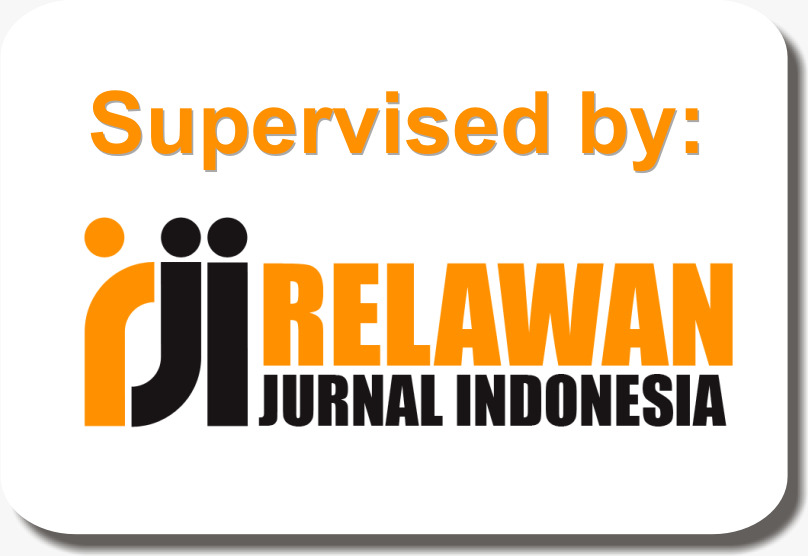TRANSFORMASI DESAIN FESYEN VIRTUAL 3D DENGAN TEKNOLOGI ARTIFICIAL INTELLIGENCE LUMA
Abstract
Keywords
Full Text:
PDFArticle Metrics :
References
N. Nisrina, R. Ardi, and B. Tjahjono, “Designing sustainable supply chain metrics for the Indonesian fashion industry: A DEMATEL-Based ANP approach,” Clean. Eng. Technol., vol. 25, no. November 2024, p. 100921, 2025, doi: 10.1016/j.clet.2025.100921.
S. Zuliarni, D. Kartikasari, B. Hendrawan, and S. S. Windrayati Siregar, “The impact of buying intention of global fashion on local substitute: The role of product design and price,” Heliyon, vol. 9, no. 11, p. e22160, 2023, doi: 10.1016/j.heliyon.2023.e22160.
D. Yu and P. Zhao, “Research on Network Clothing Design System Based on Artificial Intelligence,” Procedia Comput. Sci., vol. 247, no. C, pp. 27–35, 2023, doi: 10.1016/j.procs.2024.10.004.
G. Gornostaeva, “Design and sustainability in the fashion industry: the example of independent labels in London,” Clean. Responsible Consum., vol. 15, no. August, p. 100221, 2024, doi: 10.1016/j.clrc.2024.100221.
& A. S. D. Af’idah, S. Handayani, M. Hidayattullah, D. Dairoh, “Peningkatan pengetahuan guru dan siswa jurusan tata busana dalam pemanfaatan aplikasi berbasis kecerdasan buatan,” DST, vol. 4, no. 1, pp. 23–34, 2024, [Online]. Available: https://doi.org/10.47709/dst.v4i1.3847
D. A. Fitriyanto and A. F. Zakariya, “Evolusi Peran Arsitek di Era Artificial Intelligence dan Teknologi Berbasis Data,” J. Arsit. TERRACOTTA, vol. 5, no. 1, pp. 23–29, 2023, doi: 10.26760/terracotta.v5i1.10619.
Y. Zhang, Z. Zheng, and L. Liu, “Design Resource Deployment for Virtual Fitting Applications in the Era of Digital Fashion: An Analysis Based on Kano-QFD,” SAGE Open, vol. 14, no. 4, pp. 1–18, 2024, doi: 10.1177/21582440241296627.
J. X. Wu and L. Li, “AI-driven computational creativity in fashion design: a review,” Text. Res. J. , vol. 95, no. 5–6, pp. 658–675, 2025, doi: 10.1177/00405175241279976.
M. A. Baronian, “Screenic fashion: horizontality, minimal materiality and manual operation,” J. Vis. Cult., vol. 19, no. 3, pp. 378–390, 2020, doi: 10.1177/1470412920966012.
Z. Wang, X. Tao, X. Zeng, Y. Xing, Z. Xu, and P. Bruniaux, “Design of Customized Garments Towards Sustainable Fashion Using 3D Digital Simulation and Machine Learning-Supported Human–Product Interactions,” Int. J. Comput. Intell. Syst., vol. 16, no. 1, 2023, doi: 10.1007/s44196-023-00189-7.
D. B. Rathore, “Integration of Artificial Intelligence& It’s Practices in Apparel Industry,” Int. J. New Media Stud., vol. 10, no. 01, pp. 25–37, 2023, doi: 10.58972/eiprmj.v10i1y23.40.
S. C. Necula, “Exploring the Impact of Time Spent Reading Product Information on E-Commerce Websites: A Machine Learning Approach to Analyze Consumer Behavior,” Behav. Sci. (Basel)., vol. 13, no. 6, 2023, doi: 10.3390/bs13060439.
& A. M. A. Chaudhary, A. Rizvi, N. Kumar, “A novel approach for customer churn prediction in telecom using machine learning models,” pp. 11–21, 2023, [Online]. Available: https://doi.org/10.21203/rs.3.rs-3177792/v1
M. K. and J. Metz, “The applicability of machine learning algorithms in accounts receivables management,” vol. 24, no. 4, pp. 769–786, 2023, [Online]. Available: https://doi.org/10.1108/jaar-05-2022-0116
M. C. Medeiros Dantas De, Italo Jose, “Machine Learning Algorithms for Slow Fashion Consumer Prediction_ Theoretical and Managerial Implications.pdf,” 2023. [Online]. Available: https://doi.org/10.24883/iberoamericanic.v13i.439
B. Rathore, “Beyond Trends: Shaping the Future of Fashion Marketing with AI, Sustainability and Machine Learning,” Eduzone Int. peer Rev. Acad. Multidiscip. J., vol. 06, no. 02, pp. 16–24, 2023, doi: 10.56614/eiprmj.v6i2y17.341.
A. A. Altameem and A. M. Hafez, “Behavior Analysis Using Enhanced Fuzzy Clustering and Deep Learning,” Electron., vol. 11, no. 19, 2022, doi: 10.3390/electronics11193172.
S. Yi and X. Liu, “Machine learning based customer sentiment analysis for recommending shoppers, shops based on customers’ review,” Complex Intell. Syst., vol. 6, no. 3, pp. 621–634, 2020, doi: 10.1007/s40747-020-00155-2.
J. Beno, A. . Silen, and M. Yanti, “Toward sustainable fashion product development: the use of 3d virtual prototyping technologies in the synchronous remote learning classroom,” J. Lee, vol. 51, no. 2, pp. 215–235, 2022, [Online]. Available: https://doi.org/10.1177/00472395221132305
A. Spagnoli and G. Fabro Cardoso, “Dematerializing fashion. Improving design-led sustainable and hybrid retail experiences via digital twins,” Connect. Creat. times Confl., pp. 372–378, 2023, doi: 10.26530/9789401496476-073.
& H. Y. D. Koo, J. An, “Classification and analysis of fabric types for shirts: a comparison between virtual and real fabrics,” J. Eng. Fiber. Fabr., vol. 19, no. 1, pp. 37–48, 2024, [Online]. Available: https://doi.org/10.1177/15589250241262318
M. KASERIS et al., “3D Scanning Technology for the Rapid Modelling of Fashion Clothing,” pp. 17–18, 2023, doi: 10.15221/23.46.
J. Tepe and S. Koohnavard, “Fashion and game design as hybrid practices: approaches in education to creating fashion-related experiences in digital worlds,” Int. J. Fash. Des. Technol. Educ., vol. 16, no. 1, pp. 37–45, 2023, doi: 10.1080/17543266.2022.2103591.
D. N. and M. Kostić-Stanković, “Improving the economic sustainability of the fashion industry: a conceptual model proposal,” Braz Dent J., vol. 14, no. 8, p. 4726, 2022, [Online]. Available: https://doi.org/10.3390/su14084726
J. O. and O. Uddin, “Development of a computerized system for fashion business,” vol. 9, no. 1, p. 10, 2023, [Online]. Available: https://doi.org/10.57233/ijsgs.v9i1.399
S. IDREES, G. VIGNALI, and S. GILL, “3D Body Scanning with Mobile Application: An Introduction to Globalise Mass-Customisation with Pakistani Fashion E-Commerce Unstitched Apparel Industry,” pp. 17–18, 2020, doi: 10.15221/20.12.
S. Dodds, N. Palakshappa, and L. M. Stangl, “Sustainability in retail services: a transformative service research (TSR) perspective,” J. Serv. Theory Pract., vol. 32, no. 4, pp. 521–544, 2022, doi: 10.1108/JSTP-12-2021-0255.
E. Hur and T. Cassidy, “Perceptions and attitudes towards sustainable fashion design: challenges and opportunities for implementing sustainability in fashion,” Int. J. Fash. Des. Technol. Educ., vol. 12, no. 2, pp. 208–217, 2019, doi: 10.1080/17543266.2019.1572789.
& S. H. U. Hameed, S. Zaheer, N. Amin, “Exploring low-waste patternmaking techniques for sustainable solutions in fashion industry,” J. Des. Text., vol. 2, no. 2, pp. 41–64, 2023, [Online]. Available: https://doi.org/10.32350/jdt.22.03
& Y. Z. J. Ma, L. Huang, Q. Guo, “Sustainability in design: sustainable fashion design practices and environmental impact using mixed‐method analysis,” Bus. Strateg. Environ., vol. 33, no. 7, p. 6889‐6910, 2024, [Online]. Available: https://doi.org/10.1002/bse.3843
N. Aini, E. Prahastuti, and N. Ziyan, “Study on Fashion Design Students’ Difficulties in the 2018 Exhibition and Fashion Design and Demonstration Courses At the State University of Malang,” E-Journal Cult. Stud., vol. 15, no. 3, p. 24, 2022, doi: 10.24843/cs.2022.v15.i03.p03.
A. Hirscher, “Fashion Libraries as a Means for,” 2019.
M. Hatef Jalil and S. S. Shaharuddin, “Fashion Designer Behavior Toward Eco-Fashion Design,” J. Vis. Art Des., vol. 12, no. 1, pp. 1–24, 2020, doi: 10.5614/j.vad.2020.12.1.1.
E. D. and F. Vacca, “Fashion design for sustainability. a transformative challenge across the european fashion education system,” Int. Conf. High. Educ. Adv., vol. 75, no. 17, pp. 399–405, 2021, [Online]. Available: https://doi.org/10.4995/head21.2021.13029
S. H. and P. Walt, “Design optimisation of tpu modular footwear for sustainable fashion: a south african fashion week case study,” Matec Web Conf., vol. 388, pp. 1–23, 2023, [Online]. Available: https://doi.org/10.1051/matecconf/202338805005
J. Cai and J. Su, “Application Characteristics and Innovation of Digital Technology in Visual Communication Design,” vol. 2022, 2022, doi: 10.1155/2022/8806770.
& W. W. J. Peña, I. Koebner, “Using digital art and attachment priming in a web-based serious game to reduce pain and social disconnection in individuals with chronic pain and loneliness: randomized controlled trial,” vol. 12, no. Table 10, pp. e52294–e52294, 2024, [Online]. Available: https://doi.org/10.2196/52294
Q. Wang, “Reflections on the application of digital design in future urban construction,” TSSEHR, vol. 7, no. Table 10, pp. 310–315, 2024, [Online]. Available: https://doi.org/10.62051/e7vm3z27
G. R. and D. Casciani, “A.i. into fashion processes,” FH, vol. 2, no. Table 10, pp. 12–20, 2024, [Online]. Available: https://doi.org/10.36253/fh-2490
& P. B. C. Giri, S. Jain, X. Zeng, “A detailed review of artificial intelligence applied in the fashion and apparel industry,” Ieee Access, vol. 7, no. 1, pp. 95376–95396, 2019, [Online]. Available: https://doi.org/10.1109/access.2019.2928979
J. Bieńkowska, “The effects of artificial intelligence on the fashion industry—opportunities and challenges for sustainable transformation,” Sustain. Dev., vol. 33, no. 3, pp. 3774–3790, 2024, [Online]. Available: https://doi.org/10.1002/sd.3312
A. Adekunle, “Application of Artificial Intelligence and Digital Technologies in Fashion Design and Innovation in Nigeria,” Int. J. Fash. Des., vol. 3, no. 1, pp. 37–48, 2024, doi: 10.47604/ijfd.2389.
O. Satkiewicz, “Rebirth: an exploration of circular fashion,” Boller Rev., vol. 7, no. Table 10, pp. 4–6, 2024, [Online]. Available: https://doi.org/10.18776/tcu/br/7/165
B. Rathore, “Fashion Sustainability in the AI Era: Opportunities and Challenges in Marketing,” Eduzone Int. peer Rev. Acad. Multidiscip. J., vol. 08, no. 02, pp. 17–24, 2019, doi: 10.56614/eiprmj.v8i2y19.362.




